by Patricia Herbig, photos by Kayte Deioma
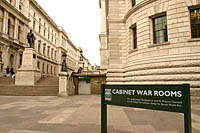 The Cabinet War Rooms was one of the very first museums I visited when we moved to London and I have been back half a dozen times since. It continues to fascinate me as the museum displays draw me into the experience. It has recently also added a new area – the Churchill Museum – to honour one of the greatest of Britain’s politician’s.
The Cabinet War Rooms was one of the very first museums I visited when we moved to London and I have been back half a dozen times since. It continues to fascinate me as the museum displays draw me into the experience. It has recently also added a new area – the Churchill Museum – to honour one of the greatest of Britain’s politician’s.
Shortly after becoming Prime Minister in May of 1940, Winston Churchill 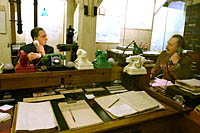 visited the War Rooms to see what preparations had been made for him and his cabinet in the event that the expected air raids on London became a reality. Upon seeing the underground Cabinet Room, he said that this was the room from which he would direct the war.
visited the War Rooms to see what preparations had been made for him and his cabinet in the event that the expected air raids on London became a reality. Upon seeing the underground Cabinet Room, he said that this was the room from which he would direct the war.
More than five years later, at the end of the war, the lights were turned off for the first time since the beginning of the war and the doors were closed; the war rooms were forgotten. In 1981, the Imperial War Museum (IWM) took over the site and converted the Cabinet War Rooms into a fascinating museum.
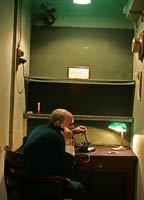 During the war years, Churchill often spent days and weeks in the underground bunker. You can see his bedroom and study just as he left it in 1945, although he only slept there a few times. There is a small cupboard, called the Transatlantic Telephone Room, with a phone that Churchill used to communicate with President Roosevelt. There is also a bedroom for his wife, Clementine Churchill, staff offices, map and communications rooms, a dining room, and a small kitchen from which it was possible to prepare the three full meals a day which Churchill required.
During the war years, Churchill often spent days and weeks in the underground bunker. You can see his bedroom and study just as he left it in 1945, although he only slept there a few times. There is a small cupboard, called the Transatlantic Telephone Room, with a phone that Churchill used to communicate with President Roosevelt. There is also a bedroom for his wife, Clementine Churchill, staff offices, map and communications rooms, a dining room, and a small kitchen from which it was possible to prepare the three full meals a day which Churchill required.
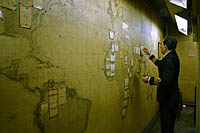 The bunker entrance of the site is still sand-bagged and leads into a new entry foyer which gives some background history. There are acoustic-guides included in the price of admission; these are strongly recommended as they give a great narrative to what you are seeing. It is possible to listen to further detail by following the directions on the audioguide.
The bunker entrance of the site is still sand-bagged and leads into a new entry foyer which gives some background history. There are acoustic-guides included in the price of admission; these are strongly recommended as they give a great narrative to what you are seeing. It is possible to listen to further detail by following the directions on the audioguide.
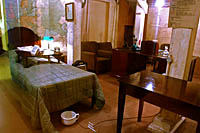 The IWM did a wonderful job of restoring the War Rooms. You get a very good sense of what it must have been like to be in those rooms during the war. Because they are underground and because people would work there for days without going outside, there are signs that tell the inhabitants what the weather is like outside.
The IWM did a wonderful job of restoring the War Rooms. You get a very good sense of what it must have been like to be in those rooms during the war. Because they are underground and because people would work there for days without going outside, there are signs that tell the inhabitants what the weather is like outside.
“We are all worms. But I do believe that I am a glow-worm.” Winston Churchill
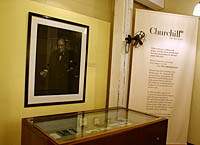 About two-thirds of the way through the Cabinet War Rooms, the IWM has created a multi-media annexe in which the Churchill collection is housed. It is divided into five colour-coded sections, each covering a separate part of Churchill’s life, starting with his childhood and moving through each major phase of his life. If you don’t know much about Churchill, it is a wonderful introduction to the man who led Britain through one of the most trying times in its history. If you do know about Churchill, you will be interested in some of the inter-active displays which feature his writing, his humour and his relationships with world political leaders and cultural icons.
About two-thirds of the way through the Cabinet War Rooms, the IWM has created a multi-media annexe in which the Churchill collection is housed. It is divided into five colour-coded sections, each covering a separate part of Churchill’s life, starting with his childhood and moving through each major phase of his life. If you don’t know much about Churchill, it is a wonderful introduction to the man who led Britain through one of the most trying times in its history. If you do know about Churchill, you will be interested in some of the inter-active displays which feature his writing, his humour and his relationships with world political leaders and cultural icons.
The Cabinet War Rooms and Churchill Museum is open daily from 9.30 – 18.00.
Address: Clive Steps, King Charles Street, London SW1A 2QA
TEL: 020-7930-6961
Admission is Ł10.00 for Adults, Ł8.00 for Senior Citizens and Free for Children under 16. Admission includes the audioguide. Additional information: www.iwm.org.uk
Public transport: Westminster or St James’s Park.
The Cabinet War Rooms and Churchill museum are included int

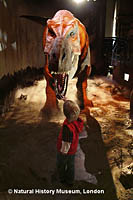 A couple of years ago, the Government decided that everyone should be able to take advantage of the wonderful museums that London has to offer; it made them all free. As a result, they are now more crowded, but as tourists, you won’t have the added expense of entry fees. My family particularly enjoys the Natural History Museum. As with all large museums, it’s best to pick a couple exhibits to see, other wise everyone is overwhelmed and the kids especially have a bad time.
A couple of years ago, the Government decided that everyone should be able to take advantage of the wonderful museums that London has to offer; it made them all free. As a result, they are now more crowded, but as tourists, you won’t have the added expense of entry fees. My family particularly enjoys the Natural History Museum. As with all large museums, it’s best to pick a couple exhibits to see, other wise everyone is overwhelmed and the kids especially have a bad time.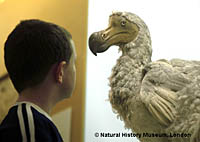 The Life Sciences section has huge fossils and dinosaur skeletons and a special exhibit in which they have a life-sized T-Rex which moves and roars. It’s a bit scary for very little children, so be warned. Other treats are rare stuffed birds, including a dodo. There are wonderful small and large fossils found along the southwest coast (named the Jurassic Coast) of England. The exhibit on Creepy Crawlies attracts kids of all ages back again and again.
The Life Sciences section has huge fossils and dinosaur skeletons and a special exhibit in which they have a life-sized T-Rex which moves and roars. It’s a bit scary for very little children, so be warned. Other treats are rare stuffed birds, including a dodo. There are wonderful small and large fossils found along the southwest coast (named the Jurassic Coast) of England. The exhibit on Creepy Crawlies attracts kids of all ages back again and again.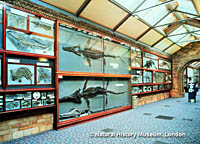 Our favorites are probably the fossils and dinosaurs and the area with the dioramas of prehistoric and modern animals. The huge fossils of prehistoric sea animals displayed on the walls are truly impressive. The smaller ones in the cases inspired us to go to Dorset and the Jurassic coast to look for more -which we indeed found!
Our favorites are probably the fossils and dinosaurs and the area with the dioramas of prehistoric and modern animals. The huge fossils of prehistoric sea animals displayed on the walls are truly impressive. The smaller ones in the cases inspired us to go to Dorset and the Jurassic coast to look for more -which we indeed found!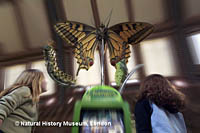 The Earth Sciences exhibits are reached up a long escalator in the main entry hall. You enter through a gallery of rare crystals in cases which are lit with black light to enhance the color
The Earth Sciences exhibits are reached up a long escalator in the main entry hall. You enter through a gallery of rare crystals in cases which are lit with black light to enhance the color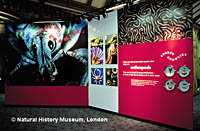 There is also a room fitted out as a small grocery shop in Kobe. Every couple of minutes, there is a recreation of what it would have been like to have been in the shop at the moment of the earthquake – initial tremours, then stronger and stronger shaking.
There is also a room fitted out as a small grocery shop in Kobe. Every couple of minutes, there is a recreation of what it would have been like to have been in the shop at the moment of the earthquake – initial tremours, then stronger and stronger shaking.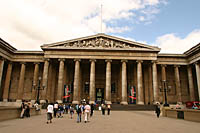 French, American and English teams have done most of the archaeological excavation in Egypt. They each brought home a wealth of treasures which found homes in the Louvre, the Metropolitan Museum of Art and the British Museum. Despite a fascination with ancient Egypt, it was not the mummies that brought me to the British Museum. It was the Celts and the Anglo Saxons. You won’t find many of their ancient arts at the Louvre or the Met. The Brits keep their ancestral artifacts close to home. This is why, despite my penchant for less common pursuits on a rainy day, I happily joined the crowds of school children and tourists descending on the British Museum. I wanted to see what the Celtic half of my ancestors had been up to a couple millennia ago.
French, American and English teams have done most of the archaeological excavation in Egypt. They each brought home a wealth of treasures which found homes in the Louvre, the Metropolitan Museum of Art and the British Museum. Despite a fascination with ancient Egypt, it was not the mummies that brought me to the British Museum. It was the Celts and the Anglo Saxons. You won’t find many of their ancient arts at the Louvre or the Met. The Brits keep their ancestral artifacts close to home. This is why, despite my penchant for less common pursuits on a rainy day, I happily joined the crowds of school children and tourists descending on the British Museum. I wanted to see what the Celtic half of my ancestors had been up to a couple millennia ago.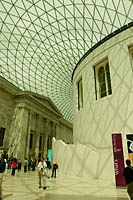 The building which houses the British Museum has gone through a variety of incarnations. The main entrance is through the Greek Revival South Front. This is part of a quadrangle of buildings completed in the mid-1850’s. After this expansion, they were still short of space, so they built a glass dome over the courtyard with the circular Reading Room at its center. It’s a unique space with the colonnades of the old buildings now making up the interior walls of the Great Court, surrounding the multi-level Reading Room.
The building which houses the British Museum has gone through a variety of incarnations. The main entrance is through the Greek Revival South Front. This is part of a quadrangle of buildings completed in the mid-1850’s. After this expansion, they were still short of space, so they built a glass dome over the courtyard with the circular Reading Room at its center. It’s a unique space with the colonnades of the old buildings now making up the interior walls of the Great Court, surrounding the multi-level Reading Room.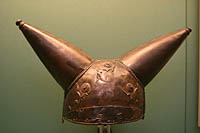 dredged up from the Thames and other river beds in Great Britain, where they had been deliberately deposited over a millennium in some form of water ritual. A circular bronze shield from 1200 to 1000 BC was found in the River Thames in London. The Chertsey Shield from 400-200 BC was dug up from a channel of the Thames in Surrey in 1985. A horned Iron-Age helmet from 150-50 BC, also found in the Thames, is the only one of its kind found anywhere in Europe.
dredged up from the Thames and other river beds in Great Britain, where they had been deliberately deposited over a millennium in some form of water ritual. A circular bronze shield from 1200 to 1000 BC was found in the River Thames in London. The Chertsey Shield from 400-200 BC was dug up from a channel of the Thames in Surrey in 1985. A horned Iron-Age helmet from 150-50 BC, also found in the Thames, is the only one of its kind found anywhere in Europe.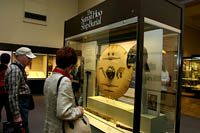 One of my favorite displays is a collection of artifacts from a burial ship found at Sutton Hoo in Suffolk. A king from the early 7 th century was buried in a 30-meter-long (97 feet) ship. They’re not sure which Anglo-Saxon king he was, but he was buried with his sword, shield, helmet, piles of clothes, barrels of food, a great cauldron to cook it in, and an impressive collection of Merovingian coins (from what’s now Belgium) dated from the early 600’s.
One of my favorite displays is a collection of artifacts from a burial ship found at Sutton Hoo in Suffolk. A king from the early 7 th century was buried in a 30-meter-long (97 feet) ship. They’re not sure which Anglo-Saxon king he was, but he was buried with his sword, shield, helmet, piles of clothes, barrels of food, a great cauldron to cook it in, and an impressive collection of Merovingian coins (from what’s now Belgium) dated from the early 600’s.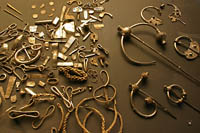 Most of the artifacts from Ireland are from the Viking period around the turn of the first millennium. Most of the Celtic items – brooches, pins and a few statues and pots – are from other parts of Europe.
Most of the artifacts from Ireland are from the Viking period around the turn of the first millennium. Most of the Celtic items – brooches, pins and a few statues and pots – are from other parts of Europe.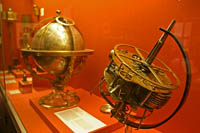 If you follow the numbered floor plan in the British wing, you go from the 7 th century through medieval times to the 19 th century and end up in the Bronze Age. I found that a bit confusing. The room on the development of the clock is kind of fun with some amazingly ornate chronometers.
If you follow the numbered floor plan in the British wing, you go from the 7 th century through medieval times to the 19 th century and end up in the Bronze Age. I found that a bit confusing. The room on the development of the clock is kind of fun with some amazingly ornate chronometers.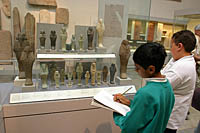 My partner in time gave me the half-hour warning, so I decided I should make a quick visit to Egypt after all. The Egyptian exhibit is on two floors. From Bronze Age Britain, I kept going north through the Ancient Near East to the Ancient Egypt exhibit along the whole north wing of the building. I rushed through the first few rooms of children sketching miniature sarcophagi and headed for the Funerary Archaeology display.
My partner in time gave me the half-hour warning, so I decided I should make a quick visit to Egypt after all. The Egyptian exhibit is on two floors. From Bronze Age Britain, I kept going north through the Ancient Near East to the Ancient Egypt exhibit along the whole north wing of the building. I rushed through the first few rooms of children sketching miniature sarcophagi and headed for the Funerary Archaeology display.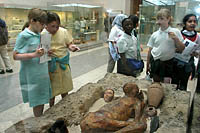 A group of kids was clustered around the reconstructed grave pit of the desiccated body of a Predynastic Egyptian Man. He had the unlikely name of Ginger, and his neighbor, the skeleton, Bones. I glanced at the questionnaire the boy next to me was filling out. “Have the skin and flesh survived?” He checked off Ginger’s box for Yes. Indeed, some hair and fingernails too. Gruesome, but fascinating.
A group of kids was clustered around the reconstructed grave pit of the desiccated body of a Predynastic Egyptian Man. He had the unlikely name of Ginger, and his neighbor, the skeleton, Bones. I glanced at the questionnaire the boy next to me was filling out. “Have the skin and flesh survived?” He checked off Ginger’s box for Yes. Indeed, some hair and fingernails too. Gruesome, but fascinating.